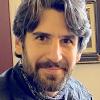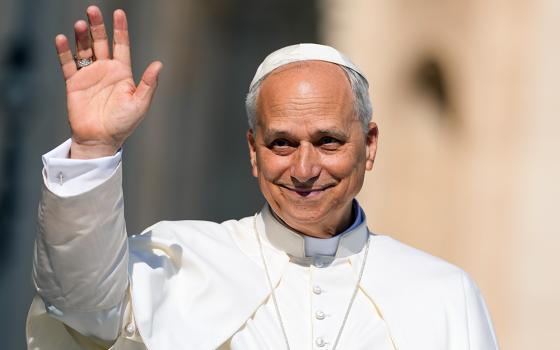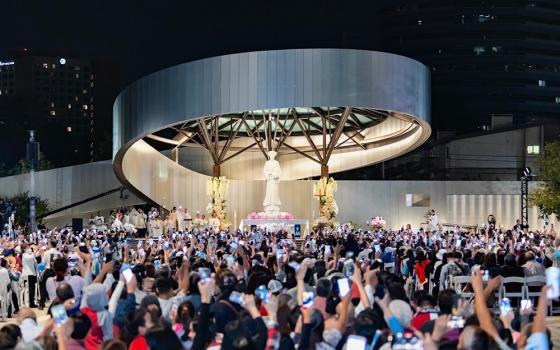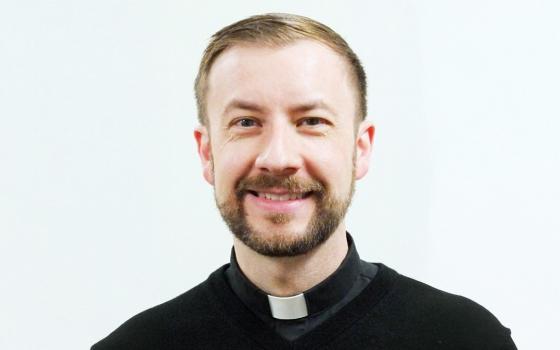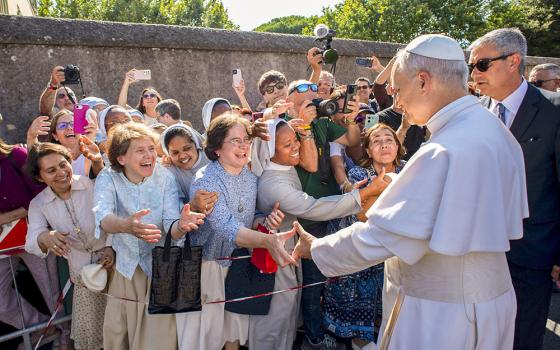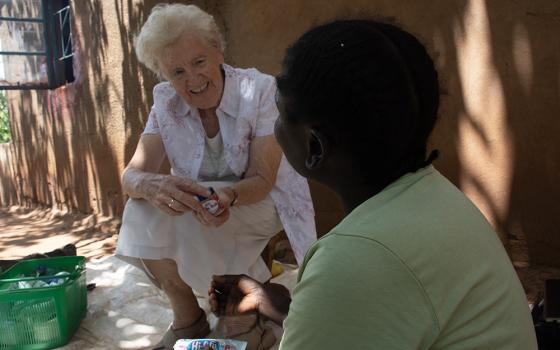
"Cross in the Mountains," by Caspar David Friedrich (Artvee)
A solitary crucifix rises out of a cleft of rock. Fir trees take the place of the two thieves traditionally positioned on either side. The tip of the cross and the tops of the trees touch the sky, a wash of sepia with a long arc of cloud like a doorway's lintel.
In many ways, "The Cross in the Mountains," a monumental drawing from 1806, establishes the visual, spiritual and symbolic vocabulary that would come to define the work of Caspar David Friedrich (1774-1840). It hangs as part of "The Soul of Nature," the first thorough survey of the German artist's career to be staged in the United States, currently on view at the Metropolitan Museum of Art through May 11.
"The Cross in the Mountains" is mirrored by another large drawing, "Statue of the Madonna in the Mountains," from 1804. With a similar compositional rhythm, the statue emerges from a stone outcrop at the center of the picture. We perceive the Madonna as an archetype for Mother Earth, so connected is she to the literal features of the landscape.
Friedrich was raised in a strict Lutheran household in the town of Greifswald on the Baltic Sea, though upbringing alone is not enough to account for the deep religiosity of his paintings. While they draw on Christian images and motifs, they are charged with a mystical reverence for nature that amplifies their symbolic meaning.
Advertisement
Take, for instance, "Morning Mist in the Mountains," an early canvas from 1807 that depicts a ragged peak shrouded in fog. The hard rock appears to dissolve into the atmosphere, hinting at the relationship between matter and spirit as the brushstrokes evoke the movement of the wind.
Contrast this with "Ruins at Oybin," where the numinous quality of "Morning Mist" is retained but rendered with architectural precision. Three lancet windows of an abandoned monastery frame a sky suffused with the holy glow of sunset. Vegetation creeps over the ruins, reminding us that humanity's story is entwined with the natural world.
The galleries of early work build to what was, for me, the centerpiece of the exhibition: "Monk by the Sea," a painting of such singular power that it seems to exist within its own self-contained universe.
In the picture, a lone monk clad in a brown habit stands with his back to the viewer, a pose known as the Rückenfigur ("back-figure") that Friedrich frequently employed. What riveted me was the sense of scale, as a vast expanse of sky dominates the upper four-fifths of the canvas, stabilized by a thin band of dark sea and a sloping white shoreline.
Even as the blue-gray tones of the sky gather to lighten from the edges to the center, the figure remains so small against the elements that it takes several glances to register his presence. I thought of the "luminous darkness" of St. John of the Cross, but also of the hiddenness of the monk's vocation that is secreted away with God.

"Monk by the Sea," by Caspar David Friedrich elicits reminders of the hiddenness of the monk’s vocation that is secreted away with God (Artvee)
Following such an intense visual experience, the sketches assembled in the next gallery came as a kind of palate cleanser. The pencil-and-watercolor study "Rocks along a Forest Path" shows Friedrich's scrupulous eye and lightness of touch. It recalled a selection from the "Karlsruhe Sketchbook" displayed earlier in the exhibition, where the artist had painstakingly drawn a fir tree needle by needle.
Seeing the sketches interspersed with the paintings was a reminder that Friedrich's attentiveness to landscape was an ongoing practice. Like any spiritual discipline, it was continually refined and renewed through sustained daily effort.
As he entered midlife, Friedrich's work took a subtler, more humble turn. The religious symbolism of the earlier canvases became less pronounced. In paintings like "Greifswald in Moonlight," which merge imagined details with careful observation, the artist purifies his vision to find the poetry in everyday scenes. This newfound simplicity is evident in "Evening: Sunset behind Dresden's Hofkirche," a twilit landscape bathed in a deep feeling of stillness.
Another work from this period, "Woman before the Rising or Setting Sun," again features the Rückenfigur motif. The female figure faces a distant mountain with palms upturned. I was drawn in by the mystery of the composition: Who is this woman? Have we caught her in a moment of prayer? If so, is it one of welcome or departure? Friedrich lets us fill in the gaps of the elliptical narrative ourselves.

"The Watzmann," by Caspar David Friedrich (Artvee)
In Friedrich's later years, the dramatic density of the early work comes together with the studied quiet of the middle period. The result is a series of paintings and drawings that exude a majestic calm.
The subject of "Bushes in the Snow (From the Dresden Heath II)" is deceptively straightforward: a tangle of leafless branches against a gray winter sky. But the longer I looked, the more I saw the traceries of church windows emerge out of the pattern. It is as if Friedrich is pointing another way toward nature as a site of revelation.
On the opposite end of the spectrum is "The Watzmann," a massive oil painting of a peak in the Bavarian Alps. What I found most intriguing is that Friedrich never visited the site, instead relying on other paintings to build his composition. His process here speaks to the role of the imagination in harmonizing art and life.
The final gallery is perhaps the most moving in the exhibition. Having suffered the effects of a stroke, with limited mobility, Friedrich took up the ink-wash method of his earliest drawings to create a suite of scenes of limpid beauty.
"Cave in the Harz," a drawing of a narrow breach in a face of rock, serves as a fitting epitaph for the artist's lifelong project. It was hard not to think of Holy Saturday as I followed Friedrich's eye into the heart of the earth. Yet as my mind connected it back to the mountains of the earlier work, so saturated with what the painter called the "spirit of nature," it was transformed into an earth already enjoined to heaven.
